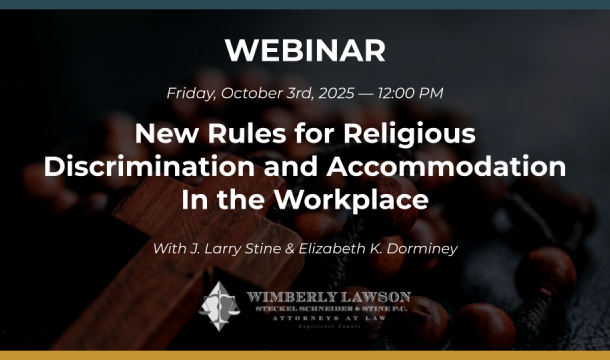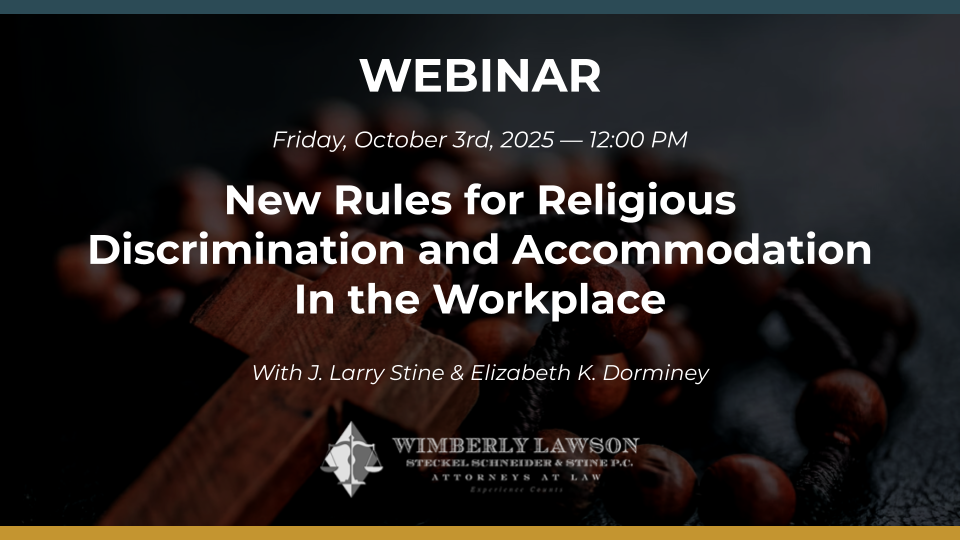The EEOC Wants to Overhaul Harassment Prevention Efforts
This week, two Commissioners of the U.S. Equal Employment Opportunity Commission (EEOC), Co-Chairs of a Select Task Force on the Study of Harassment in the Workplace, issued a detailed report on workplace harassment prevention efforts. This report was developed after 14 months of study of workplace harassment with the Select Task Force. Convened in 2015, the Select Task Force was comprised of 16 members from around the country, including representatives of academia from various social science disciplines, legal practitioners on both the plaintiff and defense side, employers and employee advocacy groups, and organized labor.
The report includes detailed recommendations for harassment prevention, including a chart of risk factors that may permit harassment to occur; effective policies and procedures to reduce and eliminate harassment; recommendations for future research and funding; and targeted outreach. In addition, it offers a toolkit of compliance assistance measures for employers and other stakeholders.
The report's key findings are as follows:
- Workplace Harassment Remains a Persistent Problem. Almost fully one third of the approximately 90,000 charges received by EEOC in fiscal year 2015 included an allegation of workplace harassment. This includes, among other things, charges of unlawful harassment on the basis of sex (including sexual orientation, gender identity, and pregnancy), race, disability, age, ethnicity/national origin, color, and religion. While there is robust data and academic literature on sex-based harassment, there is very limited data regarding harassment on other protected bases. More research is needed.
- Workplace Harassment Too Often Goes Unreported. Common workplace-based responses by those who experience sex-based harassment are to avoid the harasser, deny or downplay the gravity of the situation, or attempt to ignore, forget, or endure the behavior. The least common response to harassment is to take some formal action - either to report the harassment internally or file a formal legal complaint. Roughly three out of four individuals who experienced harassment never even talked to a supervisor, manager, or union representative about the harassing conduct. Employees who experience harassment fail to report the harassing behavior or to file a complaint because they fear disbelief of their claim, inaction on their claim, blame, or social or professional retaliation.
- There Is a Compelling Business Case for Stopping and Preventing Harassment. When employers consider the costs of workplace harassment, they often focus on legal costs, and with good reason. Last year, EEOC alone recovered $164.5 million for workers alleging harassment - and these direct costs are just the tip of the iceberg. Workplace harassment first and foremost comes at a steep cost to those who suffer it, as they experience mental, physical, and economic harm. Beyond that, workplace harassment affects all workers, and its true cost includes decreased productivity, increased turnover, and reputational harm. All of this is a drag on performance - and the bottom-line.
- It Starts at the Top - Leadership and Accountability Are Critical. Workplace culture has the greatest impact on allowing harassment to flourish, or conversely, in preventing harassment. The importance of leadership cannot be overstated - effective harassment prevention efforts, and workplace culture in which harassment is not tolerated, must start with and involve the highest level of management of the company. But a commitment (even from the top) to a diverse, inclusive, and respectful workplace is not enough. Rather, at all levels, across all positions, an organization must have systems in place that hold employees accountable for this expectation. Accountability systems must ensure that those who engage in harassment are held responsible in a meaningful, appropriate, and proportional manner, and that those whose job it is to prevent or respond to harassment should be rewarded for doing that job well (or penalized for failing to do so). Finally, leadership means ensuring that anti-harassment efforts are given the necessary time and resources to be effective.
- Training Must Change. Much of the training done over the last 30 years has not worked as a prevention tool - it's been too focused on simply avoiding legal liability. We believe effective training can reduce workplace harassment, and recognize that ineffective training can be unhelpful or even counterproductive. However, even effective training cannot occur in a vacuum - it must be part of a holistic culture of non-harassment that starts at the top. Similarly, one size does not fit all: Training is most effective when tailored to the specific workforce and workplace, and to different cohorts of employees. Finally, when trained correctly, middle-managers and first-line supervisors in particular can be an employer's most valuable resource in preventing and stopping harassment.
- New and Different Approaches to Training Should Be Explored. We heard of several new models of training that may show promise for harassment training. "Bystander intervention training" - increasingly used to combat sexual violence on school campuses - empowers co-workers and gives them the tools to intervene when they witness harassing behavior, and may show promise for harassment prevention. Workplace "civility training" that does not focus on eliminating unwelcome or offensive behavior based on characteristics protected under employment non-discrimination laws, but rather on promoting respect and civility in the workplace generally, likewise may offer solutions.
- It's On Us. Harassment in the workplace will not stop on its own - it's on all of us to be part of the fight to stop workplace harassment. We cannot be complacent bystanders and expect our workplace cultures to change themselves. For this reason, we suggest exploring the launch of an It's on Us campaign for the workplace. Originally developed to reduce sexual violence in educational settings, the It's on Us campaign is premised on the idea that students, faculty, and campus staff should be empowered to be part of the solution to sexual assault, and should be provided the tools and resources to prevent sexual assault as engaged bystanders. Launching a similar It's on Us campaign in workplaces across the nation - large and small, urban and rural - is an audacious goal. But doing so could transform the problem of workplace harassment from being about targets, harassers, and legal compliance, into one in which co-workers, supervisors, clients, and customers all have roles to play in stopping such harassment.
The findings regarding the effectiveness of harassment training are controversial and, in the opinion of this legal professional who has conducted harassment prevention training, not entirely accurate. It has been my experience that most employers recognize the economic and other costs of workplace harassment and conduct training to educate the workforce in a genuine effort to prevent harassment, and not just to avoid legal liability. Furthermore, while the goal of training employees in "bystander intervention" is laudable, this appears to be an academically based idea that may not translate well to the workplace setting where most em

Kathleen J. Jennings is a former principal in the Atlanta office of Wimberly, Lawson, Steckel, Schneider, & Stine, P.C. She defends employers in employment matters, such as sexual harassment, discrimination, Wage and Hour, OSHA, restrictive covenants, and other employment litigation and provides training and counseling to employers in employment matters.
Related Content
Get Email Updates
Recent Content

Trump Nominates Appointments to NLRB and EEOC but Policy Changes Likely to Be Delayed

DOL Launches Self-Audit Programs Designed to Help Employers Improve Compliance

DOL Must Release EEO-1 Reports to the Public under Open Records Laws

Current Advice on Active-Shooter Situations

New Policy for Federal Workers and Religious Expressions

